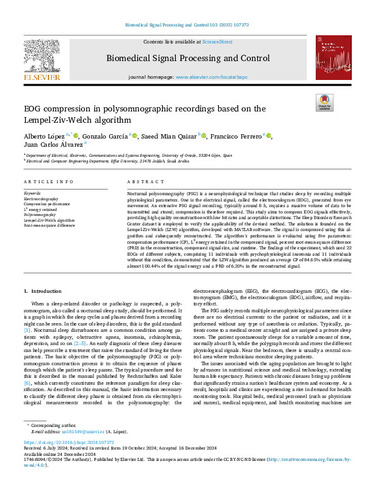EOG compression in polysomnographic recordings based on the Lempel-Ziv-Welch algorithm
Fecha de publicación:
Versión del editor:
Citación:
Resumen:
Nocturnal polysomnography (PSG) is a neurophysiological technique that studies sleep by recording multiple physiological parameters. One is the electrical signal, called the electrooculogram (EOG), generated from eye movement. An extensive PSG signal recording, typically around 8 h, requires a massive volume of data to be transmitted and stored; compression is therefore required. This study aims to compress EOG signals effectively, providing high-quality reconstruction with low bit rates and acceptable distortions. The Sleep Disorders Research Center dataset is employed to verify the applicability of the devised method. The solution is founded on the Lempel-Ziv-Welch (LZW) algorithm, developed with MATLAB software. The signal is compressed using this algorithm and subsequently reconstructed. The algorithm’s performance is evaluated using five parameters: compression performance (CP), L2 energy retained in the compressed signal, percent root-mean-square difference (PRD) in the reconstruction, compressed signal size, and runtime. The findings of the experiment, which used 22 EOGs of different subjects, comprising 11 individuals with psychophysiological insomnia and 11 individuals without this condition, demonstrated that the LZW algorithm produced an average CP of 84.65% while retaining almost 100.44% of the signal energy and a PRD of 6.20% in the reconstructed signal.
Nocturnal polysomnography (PSG) is a neurophysiological technique that studies sleep by recording multiple physiological parameters. One is the electrical signal, called the electrooculogram (EOG), generated from eye movement. An extensive PSG signal recording, typically around 8 h, requires a massive volume of data to be transmitted and stored; compression is therefore required. This study aims to compress EOG signals effectively, providing high-quality reconstruction with low bit rates and acceptable distortions. The Sleep Disorders Research Center dataset is employed to verify the applicability of the devised method. The solution is founded on the Lempel-Ziv-Welch (LZW) algorithm, developed with MATLAB software. The signal is compressed using this algorithm and subsequently reconstructed. The algorithm’s performance is evaluated using five parameters: compression performance (CP), L2 energy retained in the compressed signal, percent root-mean-square difference (PRD) in the reconstruction, compressed signal size, and runtime. The findings of the experiment, which used 22 EOGs of different subjects, comprising 11 individuals with psychophysiological insomnia and 11 individuals without this condition, demonstrated that the LZW algorithm produced an average CP of 84.65% while retaining almost 100.44% of the signal energy and a PRD of 6.20% in the reconstructed signal.
ISSN:
Notas Locales:
OA ATUO24
Colecciones
Ficheros en el ítem





